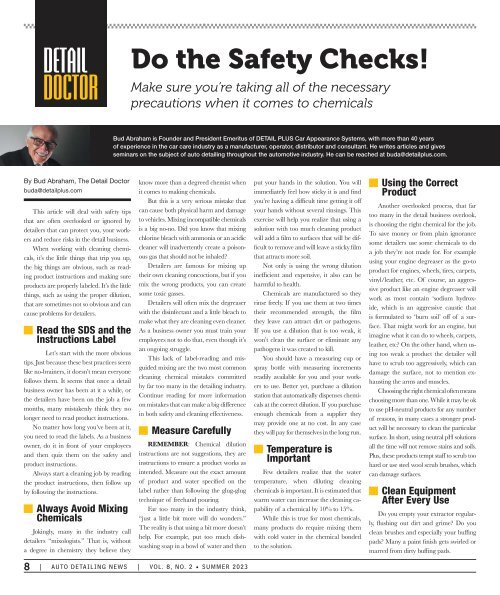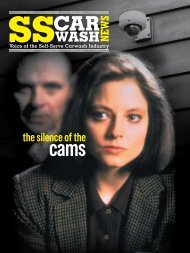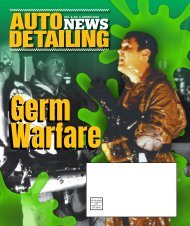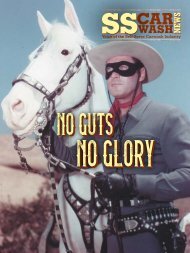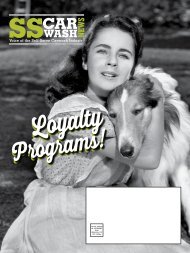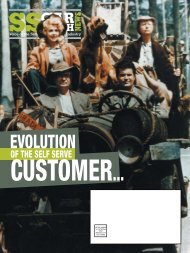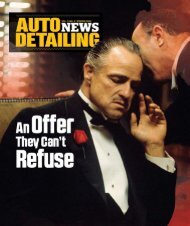ADN SPRING 2023 web
Create successful ePaper yourself
Turn your PDF publications into a flip-book with our unique Google optimized e-Paper software.
DETAIL<br />
DOCTOR<br />
Do the Safety Checks!<br />
Make sure you’re taking all of the necessary<br />
precautions when it comes to chemicals<br />
Bud Abraham is Founder and President Emeritus of DETAIL PLUS Car Appearance Systems, with more than 40 years<br />
of experience in the car care industry as a manufacturer, operator, distributor and consultant. He writes articles and gives<br />
seminars on the subject of auto detailing throughout the automotive industry. He can be reached at buda@detailplus.com.<br />
By Bud Abraham, The Detail Doctor<br />
buda@detailplus.com<br />
This article will deal with safety tips<br />
that are often overlooked or ignored by<br />
detailers that can protect you, your workers<br />
and reduce risks in the detail business.<br />
When working with cleaning chemicals,<br />
it’s the little things that trip you up,<br />
the big things are obvious, such as reading<br />
product instructions and making sure<br />
products are properly labeled. It’s the little<br />
things, such as using the proper dilution,<br />
that are sometimes not so obvious and can<br />
cause problems for detailers.<br />
Read the SDS and the<br />
Instructions Label<br />
Let’s start with the more obvious<br />
tips. Just because these best practices seem<br />
like no-brainers, it doesn’t mean everyone<br />
follows them. It seems that once a detail<br />
business owner has been at it a while, or<br />
the detailers have been on the job a few<br />
months, many mistakenly think they no<br />
longer need to read product instructions.<br />
No matter how long you’ve been at it,<br />
you need to read the labels. As a business<br />
owner, do it in front of your employees<br />
and then quiz them on the safety and<br />
product instructions.<br />
Always start a cleaning job by reading<br />
the product instructions, then follow up<br />
by following the instructions.<br />
Always Avoid Mixing<br />
Chemicals<br />
Jokingly, many in the industry call<br />
detailers “mixologists.” That is, without<br />
a degree in chemistry they believe they<br />
know more than a degreed chemist when<br />
it comes to making chemicals.<br />
But this is a very serious mistake that<br />
can cause both physical harm and damage<br />
to vehicles. Mixing incompatible chemicals<br />
is a big no-no. Did you know that mixing<br />
chlorine bleach with ammonia or an acidic<br />
cleaner will inadvertently create a poisonous<br />
gas that should not be inhaled?<br />
Detailers are famous for mixing up<br />
their own cleaning concoctions, but if you<br />
mix the wrong products, you can create<br />
some toxic gasses.<br />
Detailers will often mix the degreaser<br />
with the disinfectant and a little bleach to<br />
make what they are cleaning even cleaner.<br />
As a business owner you must train your<br />
employees not to do that, even though it’s<br />
an ongoing struggle.<br />
This lack of label-reading and misguided<br />
mixing are the two most common<br />
cleaning chemical mistakes committed<br />
by far too many in the detailing industry.<br />
Continue reading for more information<br />
on mistakes that can make a big difference<br />
in both safety and cleaning effectiveness.<br />
Measure Carefully<br />
REMEMBER: Chemical dilution<br />
instructions are not suggestions, they are<br />
instructions to ensure a product works as<br />
intended. Measure out the exact amount<br />
of product and water specified on the<br />
label rather than following the glug-glug<br />
technique of freehand pouring.<br />
Far too many in the industry think,<br />
“just a little bit more will do wonders.”<br />
The reality is that using a bit more doesn’t<br />
help. For example, put too much dishwashing<br />
soap in a bowl of water and then<br />
put your hands in the solution. You will<br />
immediately feel how sticky it is and find<br />
you’re having a difficult time getting it off<br />
your hands without several rinsings. This<br />
exercise will help you realize that using a<br />
solution with too much cleaning product<br />
will add a film to surfaces that will be difficult<br />
to remove and will leave a sticky film<br />
that attracts more soil.<br />
Not only is using the wrong dilution<br />
inefficient and expensive, it also can be<br />
harmful to health.<br />
Chemicals are manufactured so they<br />
rinse freely. If you use them at two times<br />
their recommended strength, the film<br />
they leave can attract dirt or pathogens.<br />
If you use a dilution that is too weak, it<br />
won’t clean the surface or eliminate any<br />
pathogens it was created to kill.<br />
You should have a measuring cup or<br />
spray bottle with measuring increments<br />
readily available for you and your workers<br />
to use. Better yet, purchase a dilution<br />
station that automatically dispenses chemicals<br />
at the correct dilution. If you purchase<br />
enough chemicals from a supplier they<br />
may provide one at no cost. In any case<br />
they will pay for themselves in the long run.<br />
Temperature is<br />
Important<br />
Few detailers realize that the water<br />
temperature, when diluting cleaning<br />
chemicals is important. It is estimated that<br />
warm water can increase the cleaning capability<br />
of a chemical by 10% to 15%.<br />
While this is true for most chemicals,<br />
many products do require mixing them<br />
with cold water in the chemical bonded<br />
to the solution.<br />
Using the Correct<br />
Product<br />
Another overlooked process, that far<br />
too many in the detail business overlook,<br />
is choosing the right chemical for the job.<br />
To save money or from plain ignorance<br />
some detailers use some chemicals to do<br />
a job they’re not made for. For example<br />
using your engine degreaser as the go-to<br />
product for engines, wheels, tires, carpets,<br />
vinyl/leather, etc. Of course, an aggressive<br />
product like an engine degreaser will<br />
work as most contain ‘sodium hydroxide,<br />
which is an aggressive caustic that<br />
is formulated to ‘burn soil’ off of a surface.<br />
That might work for an engine, but<br />
imagine what it can do to wheels, carpets,<br />
leather, etc? On the other hand, when using<br />
too weak a product the detailer will<br />
have to scrub too aggressively, which can<br />
damage the surface, not to mention exhausting<br />
the arms and muscles.<br />
Choosing the right chemical often means<br />
choosing more than one. While it may be ok<br />
to use pH-neutral products for any number<br />
of reasons, in many cases a stronger product<br />
will be necessary to clean the particular<br />
surface. In short, using neutral pH solutions<br />
all the time will not remove stains and soils.<br />
Plus, these products tempt staff to scrub too<br />
hard or use steel wool scrub brushes, which<br />
can damage surfaces.<br />
Clean Equipment<br />
After Every Use<br />
Do you empty your extractor regularly,<br />
flushing out dirt and grime? Do you<br />
clean brushes and especially your buffing<br />
pads? Many a paint finish gets swirled or<br />
marred from dirty buffing pads.<br />
8 | AUTO DETAILING NEWS | VOL. 8, NO. 2 • SUMMER <strong>2023</strong>


